Research Methods: Investigating Workplace Stress in the Hotel Sector
VerifiedAdded on 2020/06/06
|10
|2757
|45
Report
AI Summary
This report presents a qualitative research study on workplace stress experienced by room attendants in the hotel industry. The research explores the problem statement, highlighting the knowledge gap regarding employee stress and its impact on job performance and turnover rates. The study employs qualitative research methods, including interviews with room attendants, to understand the causes of stress, which include workload, lack of training, and poor communication. The research objectives focus on identifying the reasons for stress, understanding stress reduction strategies, and evaluating the role of management in mitigating stress. The literature review examines existing research on stress factors and coping mechanisms. The research design includes a discussion of the population, sampling approach, data collection methods (interviews), interview protocol design, and analytical approach. The report contributes to the understanding of workplace stress, offering explanations and potential improvements for management practices. It also acknowledges limitations and provides recommendations for reducing stress among room attendants. The report concludes by emphasizing the importance of understanding and addressing workplace stress to improve employee well-being and organizational performance.
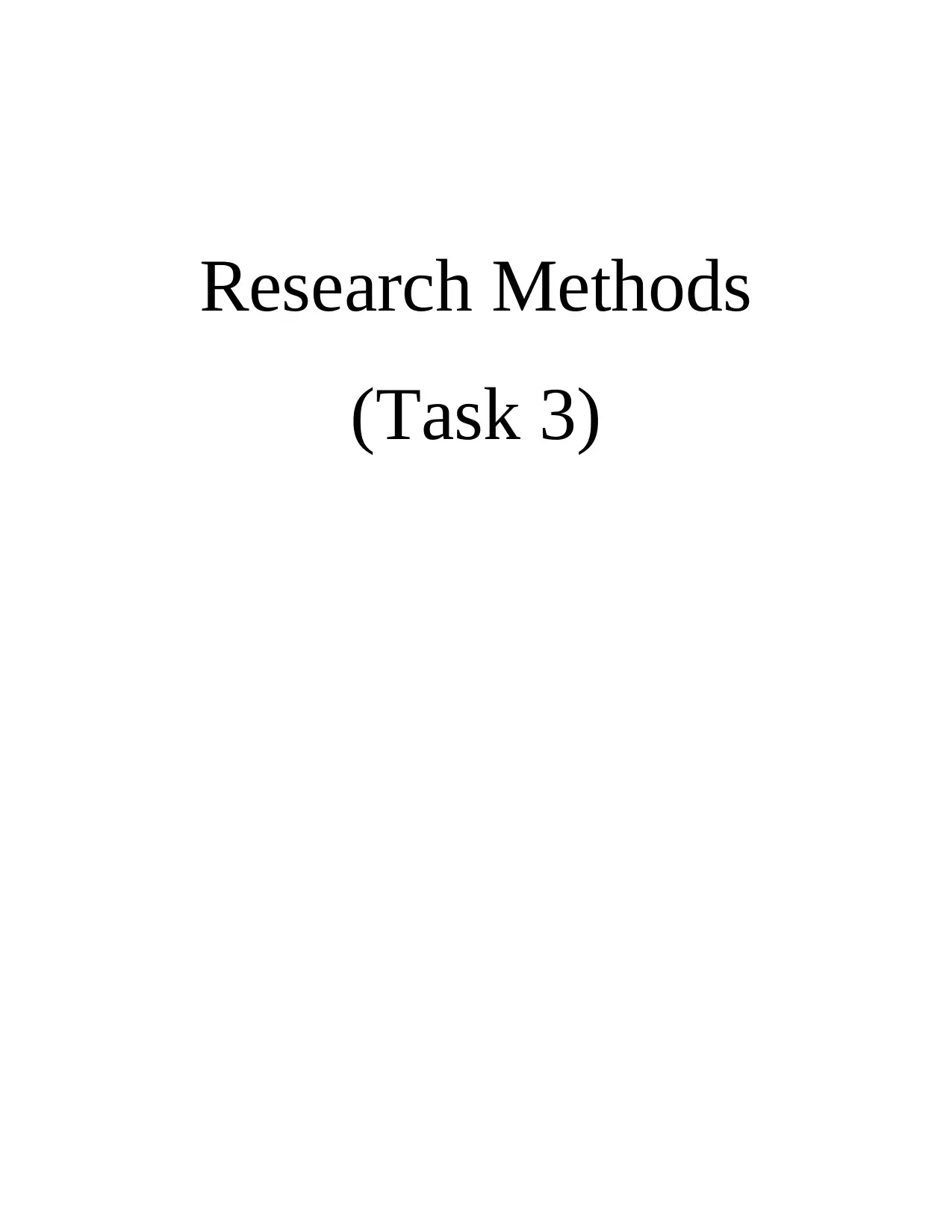
Research Methods
(Task 3)
(Task 3)
Paraphrase This Document
Need a fresh take? Get an instant paraphrase of this document with our AI Paraphraser
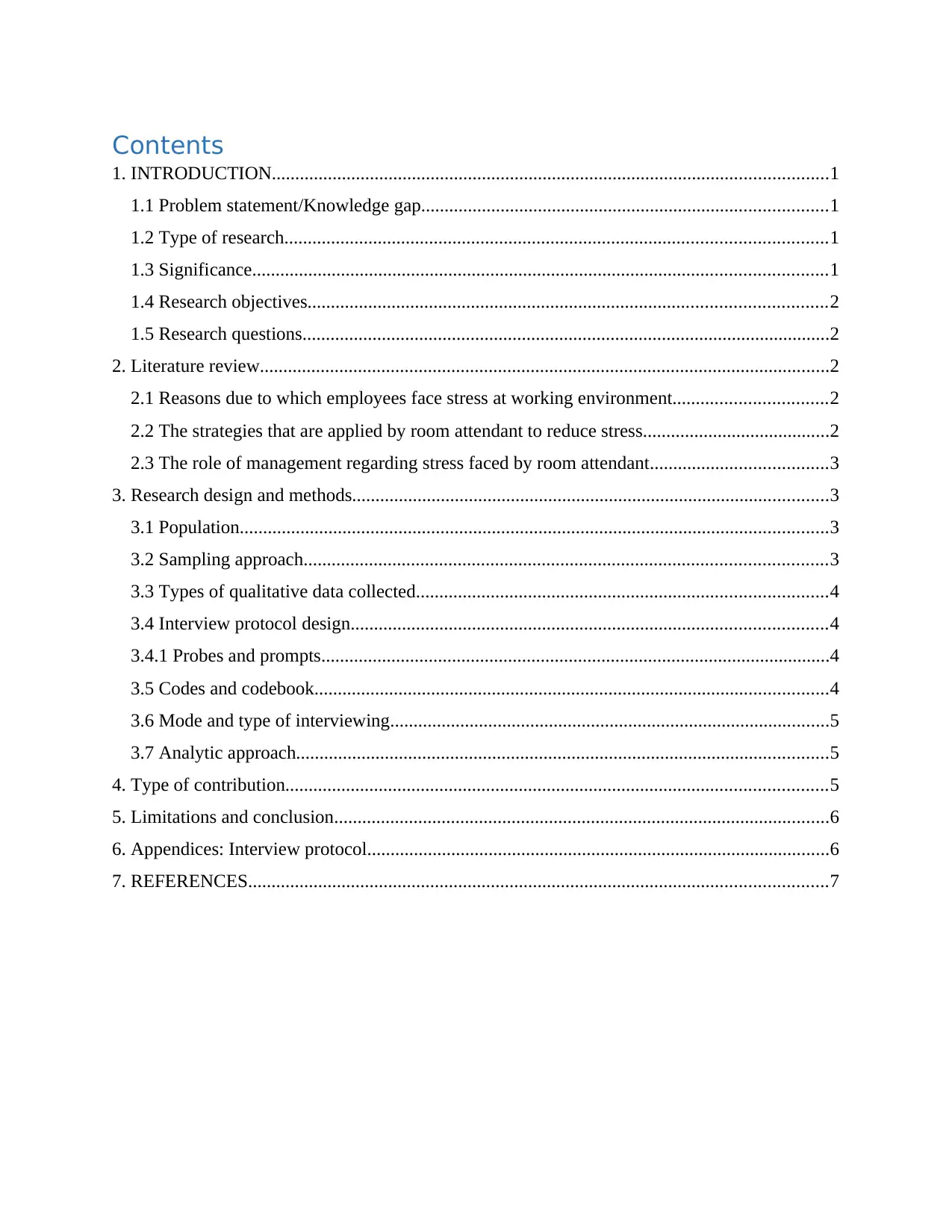
Contents
1. INTRODUCTION.......................................................................................................................1
1.1 Problem statement/Knowledge gap.......................................................................................1
1.2 Type of research....................................................................................................................1
1.3 Significance...........................................................................................................................1
1.4 Research objectives...............................................................................................................2
1.5 Research questions.................................................................................................................2
2. Literature review..........................................................................................................................2
2.1 Reasons due to which employees face stress at working environment.................................2
2.2 The strategies that are applied by room attendant to reduce stress........................................2
2.3 The role of management regarding stress faced by room attendant......................................3
3. Research design and methods......................................................................................................3
3.1 Population..............................................................................................................................3
3.2 Sampling approach................................................................................................................3
3.3 Types of qualitative data collected........................................................................................4
3.4 Interview protocol design......................................................................................................4
3.4.1 Probes and prompts.............................................................................................................4
3.5 Codes and codebook..............................................................................................................4
3.6 Mode and type of interviewing..............................................................................................5
3.7 Analytic approach..................................................................................................................5
4. Type of contribution....................................................................................................................5
5. Limitations and conclusion..........................................................................................................6
6. Appendices: Interview protocol...................................................................................................6
7. REFERENCES............................................................................................................................7
1. INTRODUCTION.......................................................................................................................1
1.1 Problem statement/Knowledge gap.......................................................................................1
1.2 Type of research....................................................................................................................1
1.3 Significance...........................................................................................................................1
1.4 Research objectives...............................................................................................................2
1.5 Research questions.................................................................................................................2
2. Literature review..........................................................................................................................2
2.1 Reasons due to which employees face stress at working environment.................................2
2.2 The strategies that are applied by room attendant to reduce stress........................................2
2.3 The role of management regarding stress faced by room attendant......................................3
3. Research design and methods......................................................................................................3
3.1 Population..............................................................................................................................3
3.2 Sampling approach................................................................................................................3
3.3 Types of qualitative data collected........................................................................................4
3.4 Interview protocol design......................................................................................................4
3.4.1 Probes and prompts.............................................................................................................4
3.5 Codes and codebook..............................................................................................................4
3.6 Mode and type of interviewing..............................................................................................5
3.7 Analytic approach..................................................................................................................5
4. Type of contribution....................................................................................................................5
5. Limitations and conclusion..........................................................................................................6
6. Appendices: Interview protocol...................................................................................................6
7. REFERENCES............................................................................................................................7
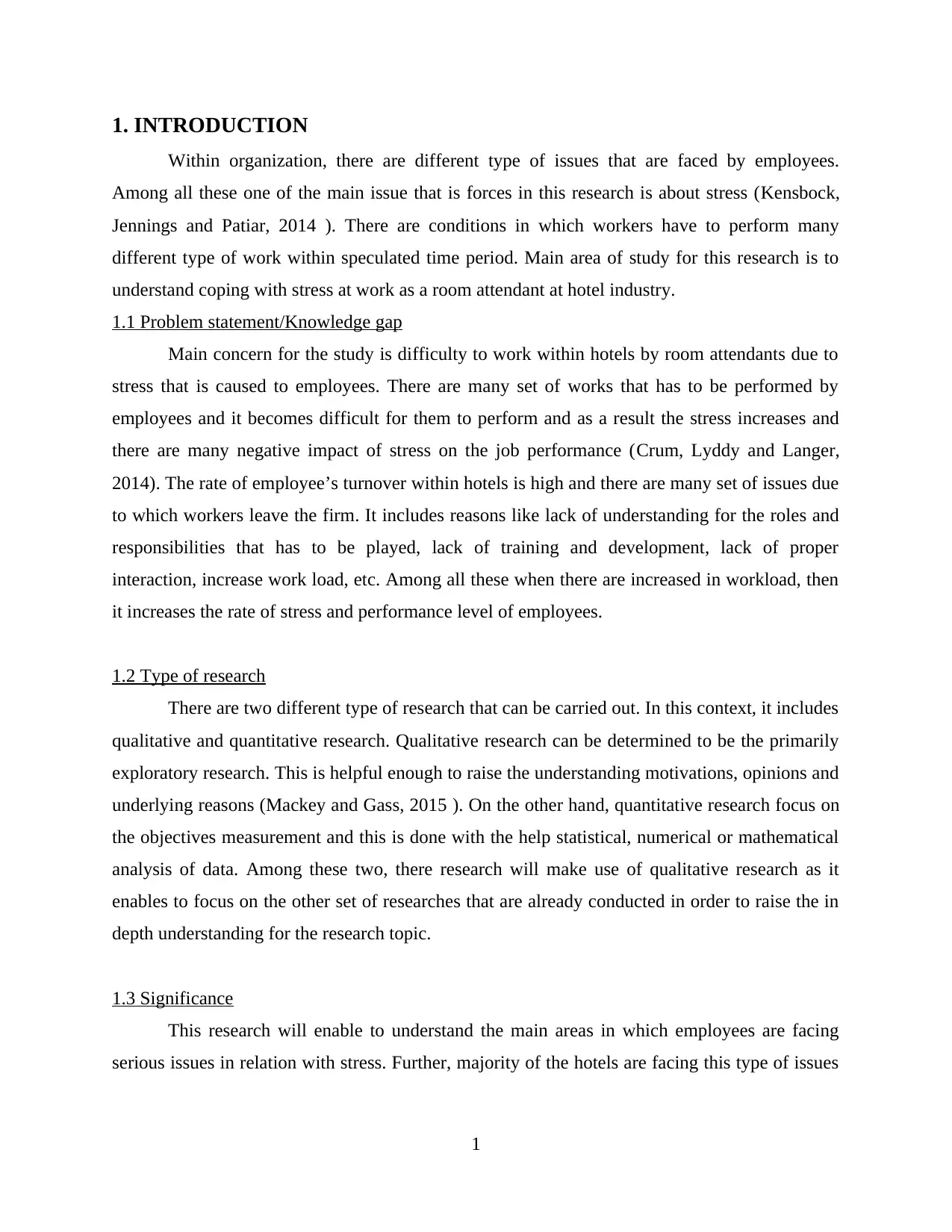
1. INTRODUCTION
Within organization, there are different type of issues that are faced by employees.
Among all these one of the main issue that is forces in this research is about stress (Kensbock,
Jennings and Patiar, 2014 ). There are conditions in which workers have to perform many
different type of work within speculated time period. Main area of study for this research is to
understand coping with stress at work as a room attendant at hotel industry.
1.1 Problem statement/Knowledge gap
Main concern for the study is difficulty to work within hotels by room attendants due to
stress that is caused to employees. There are many set of works that has to be performed by
employees and it becomes difficult for them to perform and as a result the stress increases and
there are many negative impact of stress on the job performance (Crum, Lyddy and Langer,
2014). The rate of employee’s turnover within hotels is high and there are many set of issues due
to which workers leave the firm. It includes reasons like lack of understanding for the roles and
responsibilities that has to be played, lack of training and development, lack of proper
interaction, increase work load, etc. Among all these when there are increased in workload, then
it increases the rate of stress and performance level of employees.
1.2 Type of research
There are two different type of research that can be carried out. In this context, it includes
qualitative and quantitative research. Qualitative research can be determined to be the primarily
exploratory research. This is helpful enough to raise the understanding motivations, opinions and
underlying reasons (Mackey and Gass, 2015 ). On the other hand, quantitative research focus on
the objectives measurement and this is done with the help statistical, numerical or mathematical
analysis of data. Among these two, there research will make use of qualitative research as it
enables to focus on the other set of researches that are already conducted in order to raise the in
depth understanding for the research topic.
1.3 Significance
This research will enable to understand the main areas in which employees are facing
serious issues in relation with stress. Further, majority of the hotels are facing this type of issues
1
Within organization, there are different type of issues that are faced by employees.
Among all these one of the main issue that is forces in this research is about stress (Kensbock,
Jennings and Patiar, 2014 ). There are conditions in which workers have to perform many
different type of work within speculated time period. Main area of study for this research is to
understand coping with stress at work as a room attendant at hotel industry.
1.1 Problem statement/Knowledge gap
Main concern for the study is difficulty to work within hotels by room attendants due to
stress that is caused to employees. There are many set of works that has to be performed by
employees and it becomes difficult for them to perform and as a result the stress increases and
there are many negative impact of stress on the job performance (Crum, Lyddy and Langer,
2014). The rate of employee’s turnover within hotels is high and there are many set of issues due
to which workers leave the firm. It includes reasons like lack of understanding for the roles and
responsibilities that has to be played, lack of training and development, lack of proper
interaction, increase work load, etc. Among all these when there are increased in workload, then
it increases the rate of stress and performance level of employees.
1.2 Type of research
There are two different type of research that can be carried out. In this context, it includes
qualitative and quantitative research. Qualitative research can be determined to be the primarily
exploratory research. This is helpful enough to raise the understanding motivations, opinions and
underlying reasons (Mackey and Gass, 2015 ). On the other hand, quantitative research focus on
the objectives measurement and this is done with the help statistical, numerical or mathematical
analysis of data. Among these two, there research will make use of qualitative research as it
enables to focus on the other set of researches that are already conducted in order to raise the in
depth understanding for the research topic.
1.3 Significance
This research will enable to understand the main areas in which employees are facing
serious issues in relation with stress. Further, majority of the hotels are facing this type of issues
1
⊘ This is a preview!⊘
Do you want full access?
Subscribe today to unlock all pages.

Trusted by 1+ million students worldwide
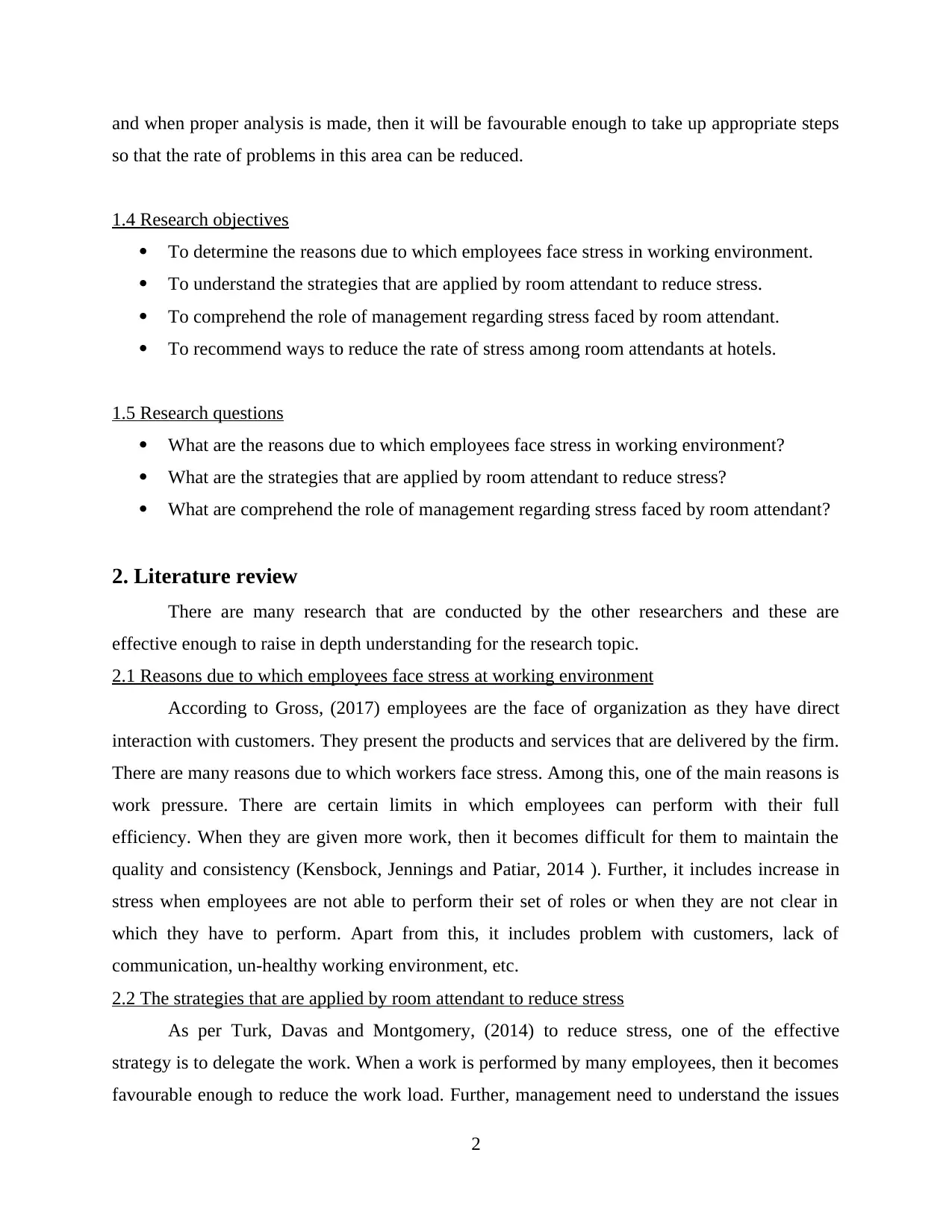
and when proper analysis is made, then it will be favourable enough to take up appropriate steps
so that the rate of problems in this area can be reduced.
1.4 Research objectives
To determine the reasons due to which employees face stress in working environment.
To understand the strategies that are applied by room attendant to reduce stress.
To comprehend the role of management regarding stress faced by room attendant.
To recommend ways to reduce the rate of stress among room attendants at hotels.
1.5 Research questions
What are the reasons due to which employees face stress in working environment?
What are the strategies that are applied by room attendant to reduce stress?
What are comprehend the role of management regarding stress faced by room attendant?
2. Literature review
There are many research that are conducted by the other researchers and these are
effective enough to raise in depth understanding for the research topic.
2.1 Reasons due to which employees face stress at working environment
According to Gross, (2017) employees are the face of organization as they have direct
interaction with customers. They present the products and services that are delivered by the firm.
There are many reasons due to which workers face stress. Among this, one of the main reasons is
work pressure. There are certain limits in which employees can perform with their full
efficiency. When they are given more work, then it becomes difficult for them to maintain the
quality and consistency (Kensbock, Jennings and Patiar, 2014 ). Further, it includes increase in
stress when employees are not able to perform their set of roles or when they are not clear in
which they have to perform. Apart from this, it includes problem with customers, lack of
communication, un-healthy working environment, etc.
2.2 The strategies that are applied by room attendant to reduce stress
As per Turk, Davas and Montgomery, (2014) to reduce stress, one of the effective
strategy is to delegate the work. When a work is performed by many employees, then it becomes
favourable enough to reduce the work load. Further, management need to understand the issues
2
so that the rate of problems in this area can be reduced.
1.4 Research objectives
To determine the reasons due to which employees face stress in working environment.
To understand the strategies that are applied by room attendant to reduce stress.
To comprehend the role of management regarding stress faced by room attendant.
To recommend ways to reduce the rate of stress among room attendants at hotels.
1.5 Research questions
What are the reasons due to which employees face stress in working environment?
What are the strategies that are applied by room attendant to reduce stress?
What are comprehend the role of management regarding stress faced by room attendant?
2. Literature review
There are many research that are conducted by the other researchers and these are
effective enough to raise in depth understanding for the research topic.
2.1 Reasons due to which employees face stress at working environment
According to Gross, (2017) employees are the face of organization as they have direct
interaction with customers. They present the products and services that are delivered by the firm.
There are many reasons due to which workers face stress. Among this, one of the main reasons is
work pressure. There are certain limits in which employees can perform with their full
efficiency. When they are given more work, then it becomes difficult for them to maintain the
quality and consistency (Kensbock, Jennings and Patiar, 2014 ). Further, it includes increase in
stress when employees are not able to perform their set of roles or when they are not clear in
which they have to perform. Apart from this, it includes problem with customers, lack of
communication, un-healthy working environment, etc.
2.2 The strategies that are applied by room attendant to reduce stress
As per Turk, Davas and Montgomery, (2014) to reduce stress, one of the effective
strategy is to delegate the work. When a work is performed by many employees, then it becomes
favourable enough to reduce the work load. Further, management need to understand the issues
2
Paraphrase This Document
Need a fresh take? Get an instant paraphrase of this document with our AI Paraphraser
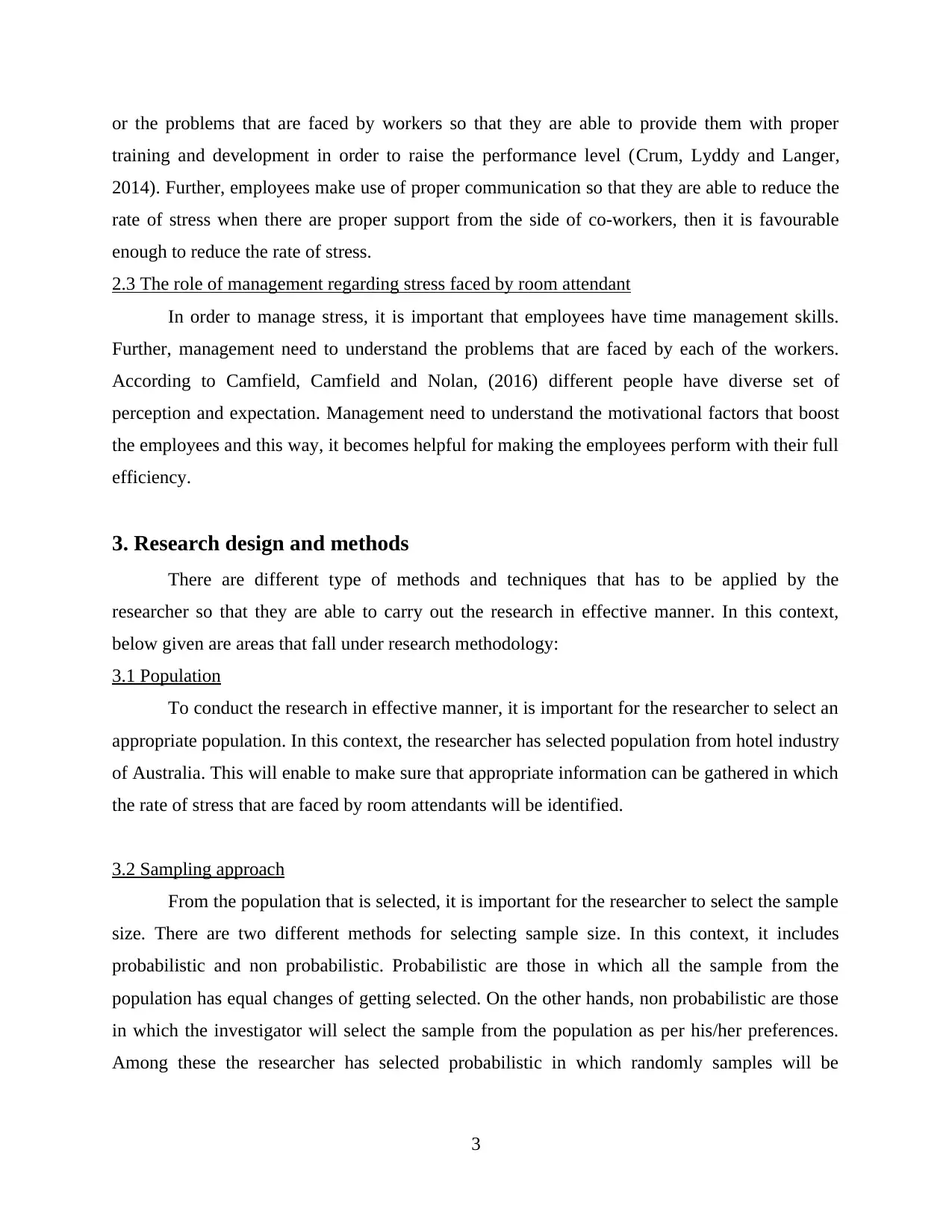
or the problems that are faced by workers so that they are able to provide them with proper
training and development in order to raise the performance level (Crum, Lyddy and Langer,
2014). Further, employees make use of proper communication so that they are able to reduce the
rate of stress when there are proper support from the side of co-workers, then it is favourable
enough to reduce the rate of stress.
2.3 The role of management regarding stress faced by room attendant
In order to manage stress, it is important that employees have time management skills.
Further, management need to understand the problems that are faced by each of the workers.
According to Camfield, Camfield and Nolan, (2016) different people have diverse set of
perception and expectation. Management need to understand the motivational factors that boost
the employees and this way, it becomes helpful for making the employees perform with their full
efficiency.
3. Research design and methods
There are different type of methods and techniques that has to be applied by the
researcher so that they are able to carry out the research in effective manner. In this context,
below given are areas that fall under research methodology:
3.1 Population
To conduct the research in effective manner, it is important for the researcher to select an
appropriate population. In this context, the researcher has selected population from hotel industry
of Australia. This will enable to make sure that appropriate information can be gathered in which
the rate of stress that are faced by room attendants will be identified.
3.2 Sampling approach
From the population that is selected, it is important for the researcher to select the sample
size. There are two different methods for selecting sample size. In this context, it includes
probabilistic and non probabilistic. Probabilistic are those in which all the sample from the
population has equal changes of getting selected. On the other hands, non probabilistic are those
in which the investigator will select the sample from the population as per his/her preferences.
Among these the researcher has selected probabilistic in which randomly samples will be
3
training and development in order to raise the performance level (Crum, Lyddy and Langer,
2014). Further, employees make use of proper communication so that they are able to reduce the
rate of stress when there are proper support from the side of co-workers, then it is favourable
enough to reduce the rate of stress.
2.3 The role of management regarding stress faced by room attendant
In order to manage stress, it is important that employees have time management skills.
Further, management need to understand the problems that are faced by each of the workers.
According to Camfield, Camfield and Nolan, (2016) different people have diverse set of
perception and expectation. Management need to understand the motivational factors that boost
the employees and this way, it becomes helpful for making the employees perform with their full
efficiency.
3. Research design and methods
There are different type of methods and techniques that has to be applied by the
researcher so that they are able to carry out the research in effective manner. In this context,
below given are areas that fall under research methodology:
3.1 Population
To conduct the research in effective manner, it is important for the researcher to select an
appropriate population. In this context, the researcher has selected population from hotel industry
of Australia. This will enable to make sure that appropriate information can be gathered in which
the rate of stress that are faced by room attendants will be identified.
3.2 Sampling approach
From the population that is selected, it is important for the researcher to select the sample
size. There are two different methods for selecting sample size. In this context, it includes
probabilistic and non probabilistic. Probabilistic are those in which all the sample from the
population has equal changes of getting selected. On the other hands, non probabilistic are those
in which the investigator will select the sample from the population as per his/her preferences.
Among these the researcher has selected probabilistic in which randomly samples will be
3
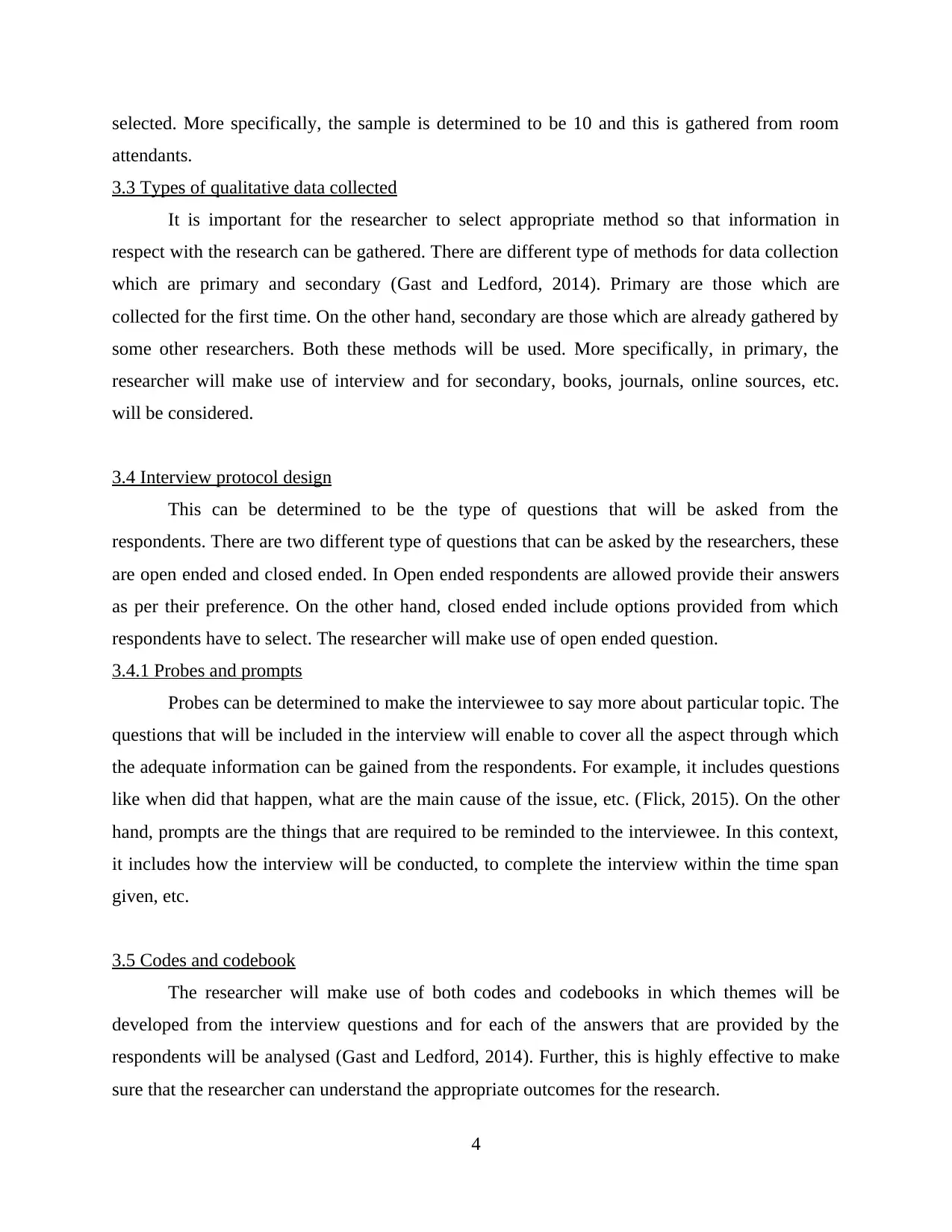
selected. More specifically, the sample is determined to be 10 and this is gathered from room
attendants.
3.3 Types of qualitative data collected
It is important for the researcher to select appropriate method so that information in
respect with the research can be gathered. There are different type of methods for data collection
which are primary and secondary (Gast and Ledford, 2014). Primary are those which are
collected for the first time. On the other hand, secondary are those which are already gathered by
some other researchers. Both these methods will be used. More specifically, in primary, the
researcher will make use of interview and for secondary, books, journals, online sources, etc.
will be considered.
3.4 Interview protocol design
This can be determined to be the type of questions that will be asked from the
respondents. There are two different type of questions that can be asked by the researchers, these
are open ended and closed ended. In Open ended respondents are allowed provide their answers
as per their preference. On the other hand, closed ended include options provided from which
respondents have to select. The researcher will make use of open ended question.
3.4.1 Probes and prompts
Probes can be determined to make the interviewee to say more about particular topic. The
questions that will be included in the interview will enable to cover all the aspect through which
the adequate information can be gained from the respondents. For example, it includes questions
like when did that happen, what are the main cause of the issue, etc. (Flick, 2015). On the other
hand, prompts are the things that are required to be reminded to the interviewee. In this context,
it includes how the interview will be conducted, to complete the interview within the time span
given, etc.
3.5 Codes and codebook
The researcher will make use of both codes and codebooks in which themes will be
developed from the interview questions and for each of the answers that are provided by the
respondents will be analysed (Gast and Ledford, 2014). Further, this is highly effective to make
sure that the researcher can understand the appropriate outcomes for the research.
4
attendants.
3.3 Types of qualitative data collected
It is important for the researcher to select appropriate method so that information in
respect with the research can be gathered. There are different type of methods for data collection
which are primary and secondary (Gast and Ledford, 2014). Primary are those which are
collected for the first time. On the other hand, secondary are those which are already gathered by
some other researchers. Both these methods will be used. More specifically, in primary, the
researcher will make use of interview and for secondary, books, journals, online sources, etc.
will be considered.
3.4 Interview protocol design
This can be determined to be the type of questions that will be asked from the
respondents. There are two different type of questions that can be asked by the researchers, these
are open ended and closed ended. In Open ended respondents are allowed provide their answers
as per their preference. On the other hand, closed ended include options provided from which
respondents have to select. The researcher will make use of open ended question.
3.4.1 Probes and prompts
Probes can be determined to make the interviewee to say more about particular topic. The
questions that will be included in the interview will enable to cover all the aspect through which
the adequate information can be gained from the respondents. For example, it includes questions
like when did that happen, what are the main cause of the issue, etc. (Flick, 2015). On the other
hand, prompts are the things that are required to be reminded to the interviewee. In this context,
it includes how the interview will be conducted, to complete the interview within the time span
given, etc.
3.5 Codes and codebook
The researcher will make use of both codes and codebooks in which themes will be
developed from the interview questions and for each of the answers that are provided by the
respondents will be analysed (Gast and Ledford, 2014). Further, this is highly effective to make
sure that the researcher can understand the appropriate outcomes for the research.
4
⊘ This is a preview!⊘
Do you want full access?
Subscribe today to unlock all pages.

Trusted by 1+ million students worldwide
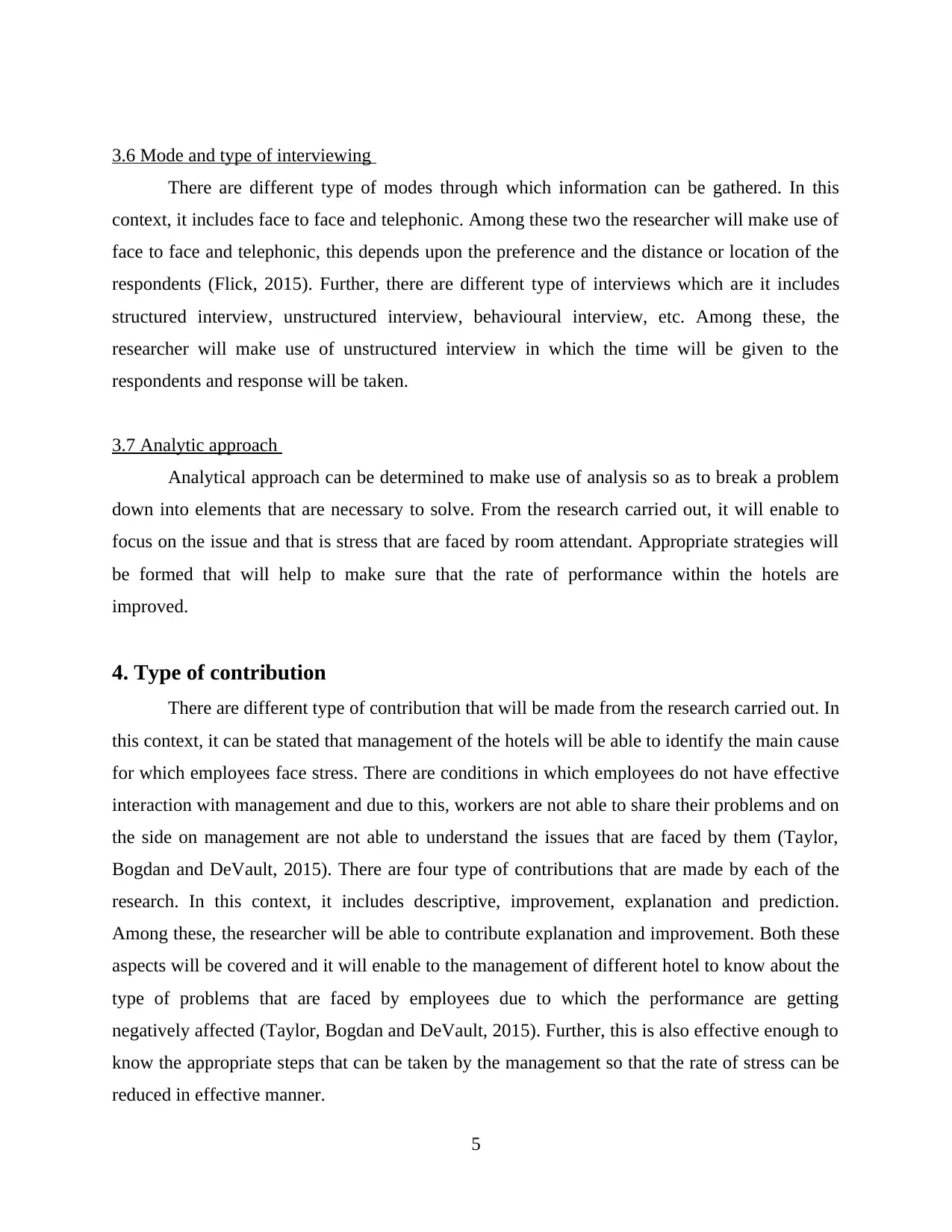
3.6 Mode and type of interviewing
There are different type of modes through which information can be gathered. In this
context, it includes face to face and telephonic. Among these two the researcher will make use of
face to face and telephonic, this depends upon the preference and the distance or location of the
respondents (Flick, 2015). Further, there are different type of interviews which are it includes
structured interview, unstructured interview, behavioural interview, etc. Among these, the
researcher will make use of unstructured interview in which the time will be given to the
respondents and response will be taken.
3.7 Analytic approach
Analytical approach can be determined to make use of analysis so as to break a problem
down into elements that are necessary to solve. From the research carried out, it will enable to
focus on the issue and that is stress that are faced by room attendant. Appropriate strategies will
be formed that will help to make sure that the rate of performance within the hotels are
improved.
4. Type of contribution
There are different type of contribution that will be made from the research carried out. In
this context, it can be stated that management of the hotels will be able to identify the main cause
for which employees face stress. There are conditions in which employees do not have effective
interaction with management and due to this, workers are not able to share their problems and on
the side on management are not able to understand the issues that are faced by them (Taylor,
Bogdan and DeVault, 2015). There are four type of contributions that are made by each of the
research. In this context, it includes descriptive, improvement, explanation and prediction.
Among these, the researcher will be able to contribute explanation and improvement. Both these
aspects will be covered and it will enable to the management of different hotel to know about the
type of problems that are faced by employees due to which the performance are getting
negatively affected (Taylor, Bogdan and DeVault, 2015). Further, this is also effective enough to
know the appropriate steps that can be taken by the management so that the rate of stress can be
reduced in effective manner.
5
There are different type of modes through which information can be gathered. In this
context, it includes face to face and telephonic. Among these two the researcher will make use of
face to face and telephonic, this depends upon the preference and the distance or location of the
respondents (Flick, 2015). Further, there are different type of interviews which are it includes
structured interview, unstructured interview, behavioural interview, etc. Among these, the
researcher will make use of unstructured interview in which the time will be given to the
respondents and response will be taken.
3.7 Analytic approach
Analytical approach can be determined to make use of analysis so as to break a problem
down into elements that are necessary to solve. From the research carried out, it will enable to
focus on the issue and that is stress that are faced by room attendant. Appropriate strategies will
be formed that will help to make sure that the rate of performance within the hotels are
improved.
4. Type of contribution
There are different type of contribution that will be made from the research carried out. In
this context, it can be stated that management of the hotels will be able to identify the main cause
for which employees face stress. There are conditions in which employees do not have effective
interaction with management and due to this, workers are not able to share their problems and on
the side on management are not able to understand the issues that are faced by them (Taylor,
Bogdan and DeVault, 2015). There are four type of contributions that are made by each of the
research. In this context, it includes descriptive, improvement, explanation and prediction.
Among these, the researcher will be able to contribute explanation and improvement. Both these
aspects will be covered and it will enable to the management of different hotel to know about the
type of problems that are faced by employees due to which the performance are getting
negatively affected (Taylor, Bogdan and DeVault, 2015). Further, this is also effective enough to
know the appropriate steps that can be taken by the management so that the rate of stress can be
reduced in effective manner.
5
Paraphrase This Document
Need a fresh take? Get an instant paraphrase of this document with our AI Paraphraser
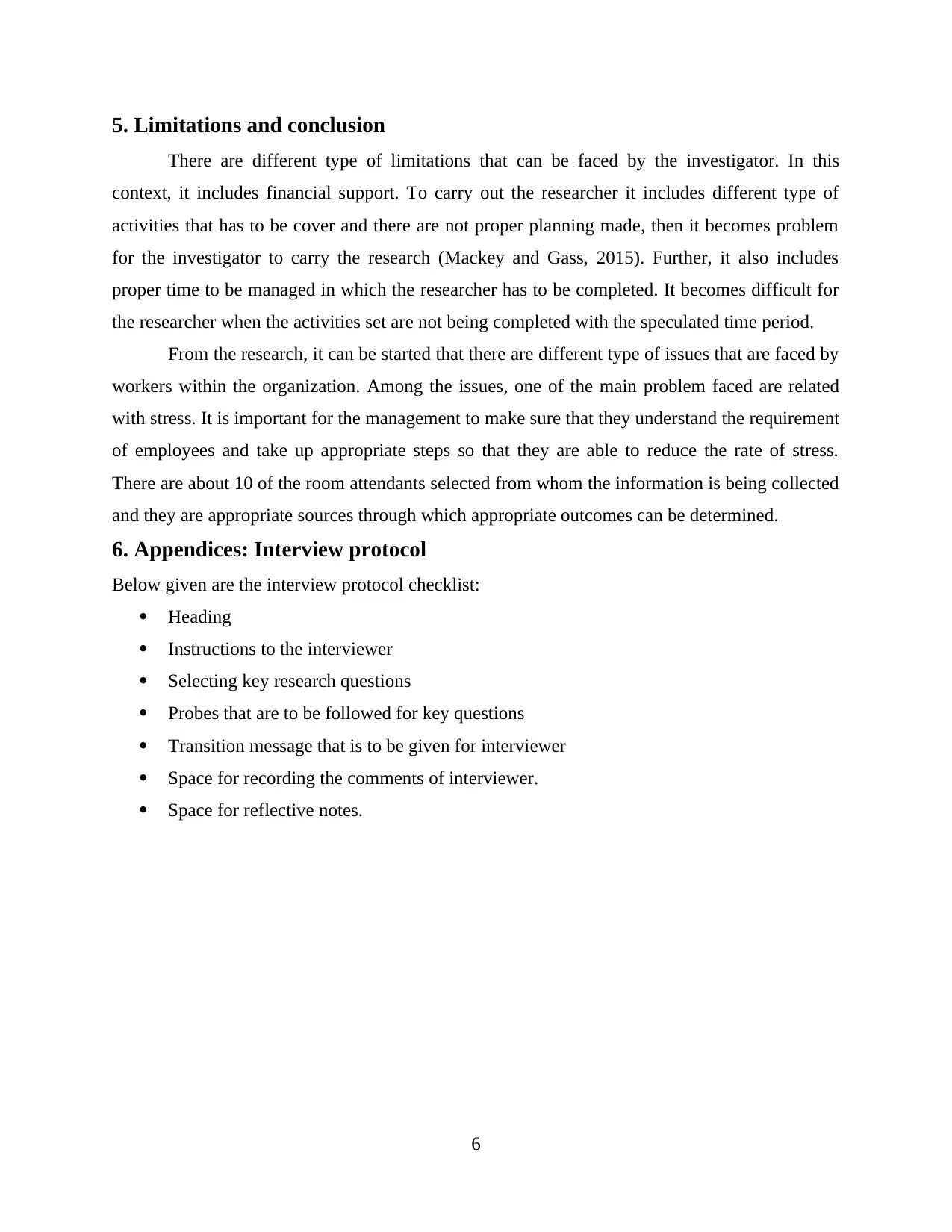
5. Limitations and conclusion
There are different type of limitations that can be faced by the investigator. In this
context, it includes financial support. To carry out the researcher it includes different type of
activities that has to be cover and there are not proper planning made, then it becomes problem
for the investigator to carry the research (Mackey and Gass, 2015). Further, it also includes
proper time to be managed in which the researcher has to be completed. It becomes difficult for
the researcher when the activities set are not being completed with the speculated time period.
From the research, it can be started that there are different type of issues that are faced by
workers within the organization. Among the issues, one of the main problem faced are related
with stress. It is important for the management to make sure that they understand the requirement
of employees and take up appropriate steps so that they are able to reduce the rate of stress.
There are about 10 of the room attendants selected from whom the information is being collected
and they are appropriate sources through which appropriate outcomes can be determined.
6. Appendices: Interview protocol
Below given are the interview protocol checklist:
Heading
Instructions to the interviewer
Selecting key research questions
Probes that are to be followed for key questions
Transition message that is to be given for interviewer
Space for recording the comments of interviewer.
Space for reflective notes.
6
There are different type of limitations that can be faced by the investigator. In this
context, it includes financial support. To carry out the researcher it includes different type of
activities that has to be cover and there are not proper planning made, then it becomes problem
for the investigator to carry the research (Mackey and Gass, 2015). Further, it also includes
proper time to be managed in which the researcher has to be completed. It becomes difficult for
the researcher when the activities set are not being completed with the speculated time period.
From the research, it can be started that there are different type of issues that are faced by
workers within the organization. Among the issues, one of the main problem faced are related
with stress. It is important for the management to make sure that they understand the requirement
of employees and take up appropriate steps so that they are able to reduce the rate of stress.
There are about 10 of the room attendants selected from whom the information is being collected
and they are appropriate sources through which appropriate outcomes can be determined.
6. Appendices: Interview protocol
Below given are the interview protocol checklist:
Heading
Instructions to the interviewer
Selecting key research questions
Probes that are to be followed for key questions
Transition message that is to be given for interviewer
Space for recording the comments of interviewer.
Space for reflective notes.
6
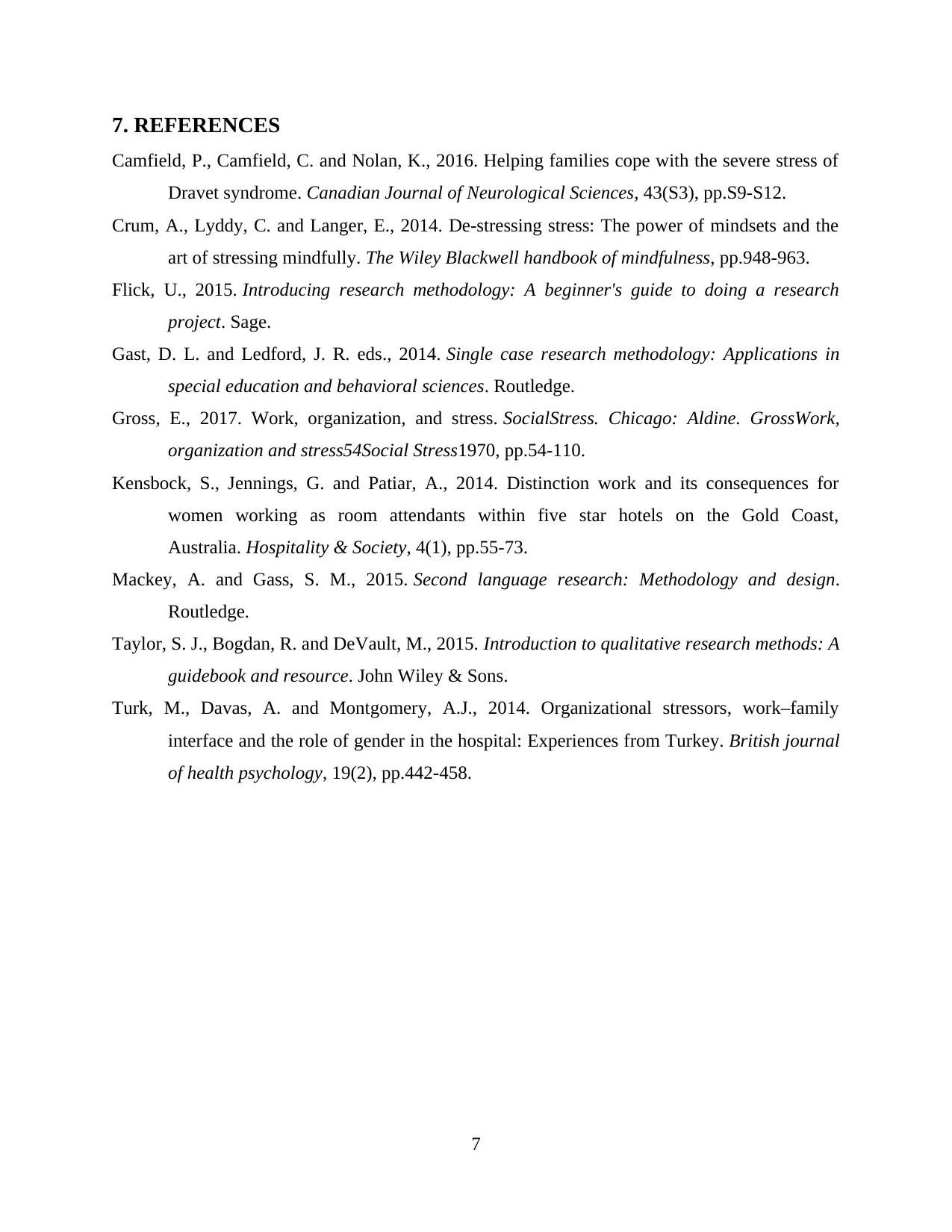
7. REFERENCES
Camfield, P., Camfield, C. and Nolan, K., 2016. Helping families cope with the severe stress of
Dravet syndrome. Canadian Journal of Neurological Sciences, 43(S3), pp.S9-S12.
Crum, A., Lyddy, C. and Langer, E., 2014. De-stressing stress: The power of mindsets and the
art of stressing mindfully. The Wiley Blackwell handbook of mindfulness, pp.948-963.
Flick, U., 2015. Introducing research methodology: A beginner's guide to doing a research
project. Sage.
Gast, D. L. and Ledford, J. R. eds., 2014. Single case research methodology: Applications in
special education and behavioral sciences. Routledge.
Gross, E., 2017. Work, organization, and stress. SocialStress. Chicago: Aldine. GrossWork,
organization and stress54Social Stress1970, pp.54-110.
Kensbock, S., Jennings, G. and Patiar, A., 2014. Distinction work and its consequences for
women working as room attendants within five star hotels on the Gold Coast,
Australia. Hospitality & Society, 4(1), pp.55-73.
Mackey, A. and Gass, S. M., 2015. Second language research: Methodology and design.
Routledge.
Taylor, S. J., Bogdan, R. and DeVault, M., 2015. Introduction to qualitative research methods: A
guidebook and resource. John Wiley & Sons.
Turk, M., Davas, A. and Montgomery, A.J., 2014. Organizational stressors, work–family
interface and the role of gender in the hospital: Experiences from Turkey. British journal
of health psychology, 19(2), pp.442-458.
7
Camfield, P., Camfield, C. and Nolan, K., 2016. Helping families cope with the severe stress of
Dravet syndrome. Canadian Journal of Neurological Sciences, 43(S3), pp.S9-S12.
Crum, A., Lyddy, C. and Langer, E., 2014. De-stressing stress: The power of mindsets and the
art of stressing mindfully. The Wiley Blackwell handbook of mindfulness, pp.948-963.
Flick, U., 2015. Introducing research methodology: A beginner's guide to doing a research
project. Sage.
Gast, D. L. and Ledford, J. R. eds., 2014. Single case research methodology: Applications in
special education and behavioral sciences. Routledge.
Gross, E., 2017. Work, organization, and stress. SocialStress. Chicago: Aldine. GrossWork,
organization and stress54Social Stress1970, pp.54-110.
Kensbock, S., Jennings, G. and Patiar, A., 2014. Distinction work and its consequences for
women working as room attendants within five star hotels on the Gold Coast,
Australia. Hospitality & Society, 4(1), pp.55-73.
Mackey, A. and Gass, S. M., 2015. Second language research: Methodology and design.
Routledge.
Taylor, S. J., Bogdan, R. and DeVault, M., 2015. Introduction to qualitative research methods: A
guidebook and resource. John Wiley & Sons.
Turk, M., Davas, A. and Montgomery, A.J., 2014. Organizational stressors, work–family
interface and the role of gender in the hospital: Experiences from Turkey. British journal
of health psychology, 19(2), pp.442-458.
7
⊘ This is a preview!⊘
Do you want full access?
Subscribe today to unlock all pages.

Trusted by 1+ million students worldwide

8
1 out of 10
Related Documents
Your All-in-One AI-Powered Toolkit for Academic Success.
+13062052269
info@desklib.com
Available 24*7 on WhatsApp / Email
![[object Object]](/_next/static/media/star-bottom.7253800d.svg)
Unlock your academic potential
Copyright © 2020–2025 A2Z Services. All Rights Reserved. Developed and managed by ZUCOL.




